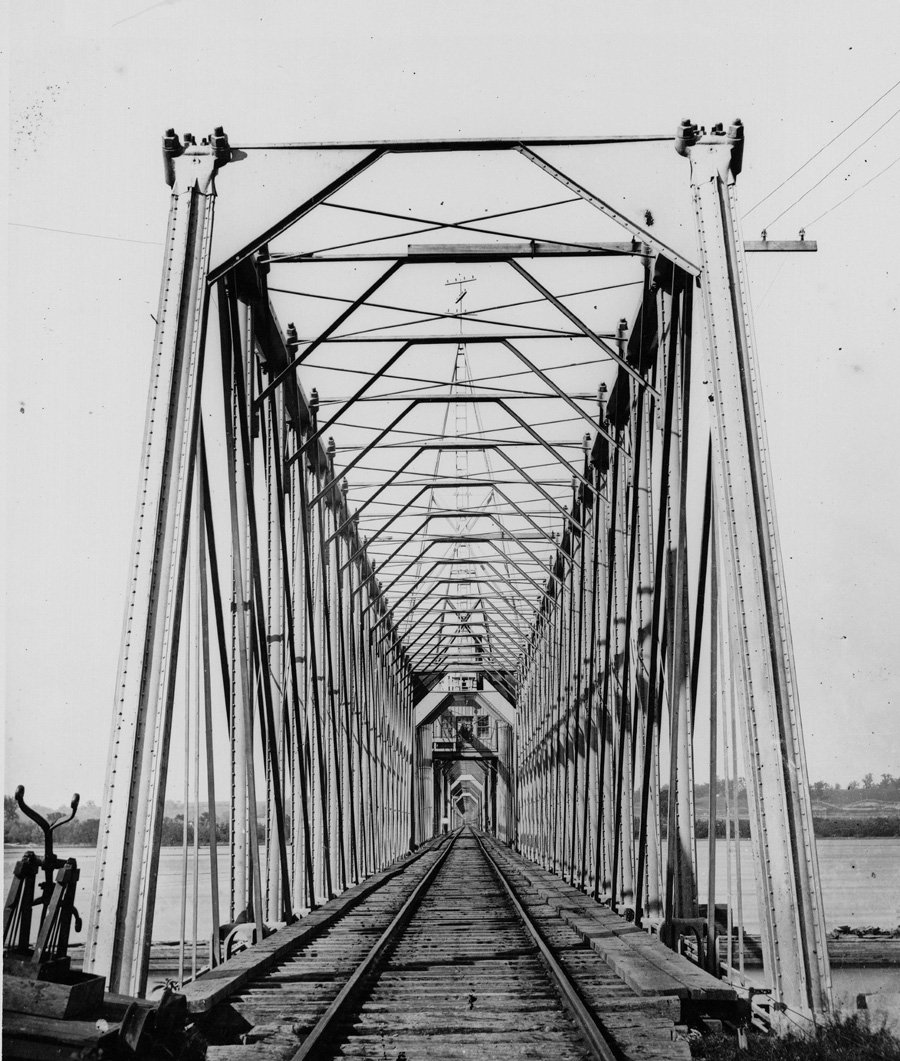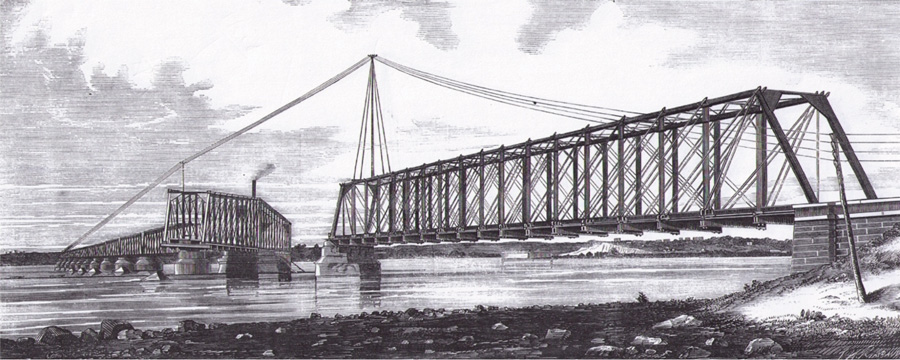Quincy Bridge, Illinois/Missouri 1868
The Quincy Bridge Company was incorporated in Illinois in 1853 and in Missouri in 1866 as part of a general act regulating the construction of roads and bridges. It was to connect Quincy, Illinois with West Quincy, Missouri. On July 25, 1866 Congress passed a bill approving construction of the bridge. This was part of a larger bill “to authorize the construction of certain bridges, and to establish them as Post-roads” and was for bridges over the Mississippi and Missouri Rivers. Section 1 stated,
Be it enacted by the Senate and House of Representatives of the United States of America, in Congress assembled:
SECTION 1. That it shall be lawful for any person or persons, company or corporation, having authority from the States of Illinois and Missouri for such purpose, to build a bridge across the Mississippi River at Quincy, Illinois…
Section 2 went on to state that if it was to be a draw bridge it should have a clearance on each side of the draw pier of 160’ and that the two adjacent spans should be of 250’ long. It also required all spans to be a minimum of 10’ above high water. If it was to be a high, continuous span it should have a 50’ clearance over the high water mark with spans no less than 250’ with one span over the main channel of 300’.

In November 1866 the bridge companies in Illinois and Missouri were merged under the name “Quincy Railroad Bridge Company.” Thomas C. Clarke was named Chief Engineer. He began work immediately surveying the previously proposed sites and in late November recommended the upper site. James Joy, Managing Director and Warren Colburn, Consulting engineer for the bridge company, however, had many ideas of their own as to how the bridge should be built. They instructed Clarke that the bridge should be iron, built at the low level with a swing and there should be no temporary wood work (trestling). Clarke and the bridge management decided to “draw up general specifications and solicit tenders from bridge builders of known ability, in conformity with these specifications.” On March 1, 1867 Clarke completed the design and sent out his request for proposals. In other words, he set the span lengths, width of the superstructure, and the material to be used. The specifications consisted of four requirements.
1. The fixed spans to be built of cast and wrought iron, the draw span of wrought iron only. Both to be of the best and toughest quality and to be subject to rigid inspection during manufacture.
2. Max. rolling load 2,500 lbs. per lineal foot, which, with weight of bridge, shall not cause a tensile strain of over 10,000 lbs. per square inch on the ties and lower chords, or 7,500 lbs. on pins, or a compressive strain on upper chords or posts of which the factor of safety shall not be less than five.
3. Workmanship to be of best quality.
4. After testing with full load, bridges shall return to original camber.

Thirteen tenders were submitted for bowstring trusses, Bollman and Fink trusses, Triangular girders (Double intersection Warren trusses), Howe trusses and Quadrangular girders (Double intersection Whipple’s). Clarke recommended the Quadrangular truss “with pin and screw connections.” He also wrote as to material, “my own choice has always been to build bridges wholly of wrought-iron. Cast-iron upper chords may be perfectly sound, but we have no means of knowing that. No inspection can detect hidden flaws in a casting. If they are of rolled form, we use a material in which the process of manufacture will reveal flaws.” He selected the proposal of the Detroit Bridge and Iron Works, the same firm that built the Clinton Bridge west spans, with cast iron upper chords, wrought iron diagonals and posts. It was also building the Burlington Bridge (STRUCTURE April 2023) at the time. The Detroit Bridge and Iron Works had recently taken control of the firm run by Charles Kellogg who opened his firm in 1857. Kellogg initially took control of construction of the bridge working with Clarke. Shortly after he left to start his own company in Buffalo, New York and new management took over.

The bridge was divided into three parts. The fixed spans were quadrangular girders with cast iron upper chords, Phoenix section rolled posts, and bottom chords composed of open links with pin connections. The main draw was a quadrangular truss (Whipple) with both chords of rolled channel beams latticed together. The contract was signed on May 6, 1867. The length of bridge over the main channel was 3,250’ consisting of a 362’ swing bridge, and 16 fixed spans with three being 200’ and two being 250’ with the other 11 being 157’ each. The first stone of the foundation was laid September 25, 1867 and the last stone August 5, 1868.
In addition it had a bridge across Quincy Bay consisting of a 190’ Bollman Truss swing bridge and 4 fixed, Bollman Deck Trusses plus a short masonry approach span at each end. These were also built by the Detroit Bridge & Iron Company. The bridge was fabricated and erected between December 1867 and November 1868.
Quality control was stressed and “every piece of wrought iron in the ties, links, bolts, &.c., was tested in a hydraulic press up to 23,600 pounds to the square inch, and struck with a hammer, while under tension, before being used in the bridge.”
The bridge was test loaded by a select panel of prominent engineers on November 7, 1868 by placing a 300,000# load both static and moving at speeds of 10 to 16 miles per hour. The deflection on one of the 250’ spans was 2.433”. On one of the 257’ spans it was only 1.374”. Both of these were close to the predicted deflection for those loads.
Clarke estimated the cost of the main bridge at $1,150,625 with the superstructure at $475,000 and the foundations at $400,000. The total cost of the Bay Bridge was $165,000 and the total cost of the entire project $1,500,000.
Clarke wrote a complete bridge description that was published by Van Nostrand’s in 1869. A review in Van Nostrand’s Eclectic Engineering Magazine ended with “The Quincy Railroad Bridge is a carefully finished structure, and with all its magnitude presents a graceful and attractive appearance.” Clarke finished his description of the bridge with, “I hope this brief description may incite other engineers to put their experience on record, so that it can be accessible to the profession. If so, I shall consider that my labor has not been wasted.”

It was replaced in 1899 with the original piers being re-used. After the Burlington Bridge (which has opened a few months before), it was the second bridge across the Mississippi to be built entirely in iron.■
Reference
Clarke’s complete bridge description published by Van Nostrand’s in 1869: (https://books.google.com/books?jtp=39&id=nKtXAAAAYAAJ#v=onepage&q&f=false)
